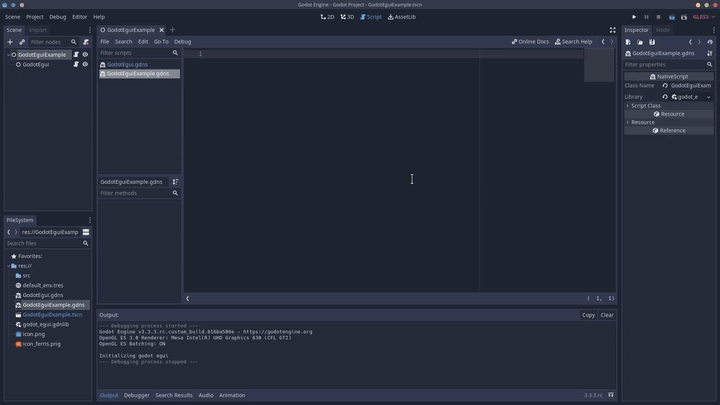An egui backend for godot-rust.
Godot has a perfectly valid GUI system, so why egui? Here are my personal reasons:
- Simplicity: No need to connect signals or manage complex scene graphs with dozens of tiny inter-related scripts. GUI logic is centralized. Everything is always up-to-date.
- Better defaults: It currently takes a lot of effort to create a visually consistent UI theme for Godot (margins, font sizes, colors...). In contrast,
egui's widgets only rely on a small set of themable properties. - Customizability: Creating new widgets with
eguiis far more simple. - Data driven: The immediate-mode paradigm fits a data-driven style of development: Your data is the source of truth, and the GUI is derived from it by navigating and updating the data itself.
- IDE Support: Rust has excellent IDE support. Static typing helps you ensure your data model and their associated GUIs always stay in sync.
These are minimal usage instructions. See the example project in ./example_project/ for a more advanced project.
First, import the godot_egui crate as a library in your project.
Cargo.toml
[dependencies]
# ...
egui = "0.13"
godot_egui = "0.1.1"Next, register the custom Godot classes declared in godot_egui:
Somewhere in your lib.rs
fn init(handle: InitHandle) {
godot_egui::register_classes(handle);
}
godot_init!(init);You will also need to create a .gdns script and attach it to a Control-derived node.
GodotEgui.gdns
[gd_resource type="NativeScript" load_steps=2 format=2]
[ext_resource path="res://godot_egui.gdnlib" type="GDNativeLibrary" id=1]
[resource]
resource_name = "GodotEgui"
class_name = "GodotEgui"
library = ExtResource( 1 )In order to handle input, GodotEgui exposes the handle_godot_input and mouse_was_captured functions that can be used to pass input events from your node into GodotEgui.
To handle input from _input or _unhandled_input use the following:
#[export]
// fn _unhandled_input(&mut self, owner: TRef<Control>, event: Ref<InputEvent>) also works.
fn _input(&mut self, owner: TRef<Control>, event: Ref<InputEvent>) {
let gui = unsafe { self.gui.as_ref().expect("GUI initialized").assume_safe() };
gui.map_mut(|gui, instance| {
gui.handle_godot_input(instance, event, false);
if gui.mouse_was_captured(instance) {
// Set the input as handled by the viewport if the gui believes that is has been captured.
unsafe { owner.get_viewport().expect("Viewport").assume_safe().set_input_as_handled() };
}
}).expect("map_mut should succeed");
}To handle input from _gui_input use the following:
#[export]
fn _gui_input(&mut self, owner: TRef<Control>, event: Ref<InputEvent>) {
let gui = unsafe { self.gui.as_ref().expect("GUI initialized").assume_safe() };
gui.map_mut(|gui, instance| {
gui.handle_godot_input(instance, event, true);
if gui.mouse_was_captured(instance) {
// `_gui_input` uses accept_event() to stop the propagation of events.
owner.accept_event();
}
}).expect("map_mut should succeed");
}GodotEgui translates the infomration from Godot's InputEvent class into the input format that egui expects. GodotEgui does not make any assumptions about how or when this data is input, it only translates and forwards the information to egui.
When determining how to handle the events, please refer to Godot's input propagation rules (see the official documentation for more details), this cannot be easily translated perfectly for every architecture. As such, it is
Note: Regarding using _gui_input with GodotEgui. You will need to ensure that you are properly configuring Control.mouse_filter and that you understand how this works with egui.
Control::MOUSE_FILTER_STOP- Consumes all input events. and it will not propagate up.Control::MOUSE_FILTER_PASS- Consumes all input events., but will allow unhandled events to propagate to the parent node.Control::MOUSE_FILTER_IGNORE- Does not consume input events.
Note regarding Control::MOUSE_FILTER_PASS:
The Godot engine assumption appears to be that most Controls that accept input will not overlap with other sibling nodes. As each GodotEgui constitutes it's own egui::Context (i.e. application), it will need to process any events that occur inside the Control.rect.size. This can lead to scenarios where input may be expected to propagate (i.e. egui does not detect that the mouse position overlaps any egui::Widget types) but does not.
The only current workaround is show in the GodotEguiWindowExample where UIs are parented to eachother in the order or priority they should response to the events.
Finally, get a reference to that node as a RefInstance<GodotEgui, Shared> in your code and do this to draw the GUI using:
let gui : RefInstance<GodotEgui, Shared> = ...;
gui.map_mut(|gui, instance| {
gui.update(instance, None, |ui| {
ui.label("Hello world!");
});
})The draw code needs to be run constantly, so you should call it from a _process callback or similar.
GodotEgui includes the ext module along with several extension traits that can be used to access the Godot Input data from egui::Ui.
These can be imported by using use godot_egui::ext::* or by importing only the extension traits that you need for your project.
use godot_egui::ext::InputMapExt;
gui.update(instance, None, |ui| {
ui.label("Is 'ui_up' pressed?");
if ui.is_action_pressed("ui_up") {
ui.label("Yes!");
}
});Should be as simple as:
- Run
cargo build - Open `./example_project/ with the Godot Editor
- Hit play
Godot Egui supports themes based on the egui-theme module of egui-stylist and ships with two addons that can be used to create export and automatically import themes into a godot usable format.
Themes are an intermediate format that will allow for more flexible serialization of egui::Style and egui::FontDefinitions structs and are fully configurable and support Serialization and Deserialization via any Serialization format that you can support.
For more information on how to create your first theme please see the egui-stylist addon's readme.
Can I use my pre-existing Godot Themes with Egui?
Unfortunately, this is not supported.
This is due to egui and Godot taking very different approaches to UI skinning. Godot has very fine grained themes and tools for modifying how widgets draw themselves while egui has far simplier sets of rules for coloring windows and widgets. As a result, there's no good way to map between the two.
Custom fonts have been removed now that Theme support has been added.
The project is in a very early release stage. Breaking changes may occur, but only when absolutely necessary.
This integration is being used in my own project, The Process.
If you use this library and enjoy it, please feel free to submit a PR and I will add it to the list!
- Initial integration and testing
- Release on crates.io
- Enable usage as an editor plugin
- Theme editor #5
- Expose a GDScript API so this is useful even without
godot-rust


